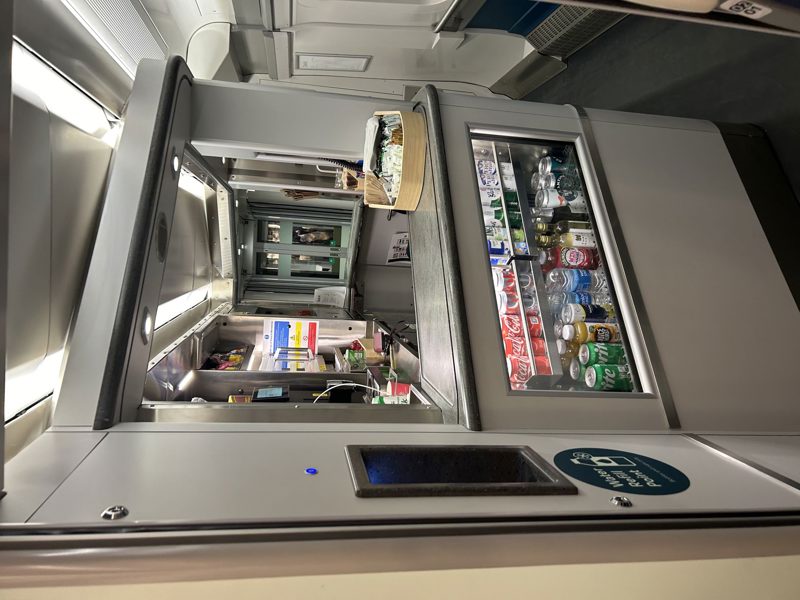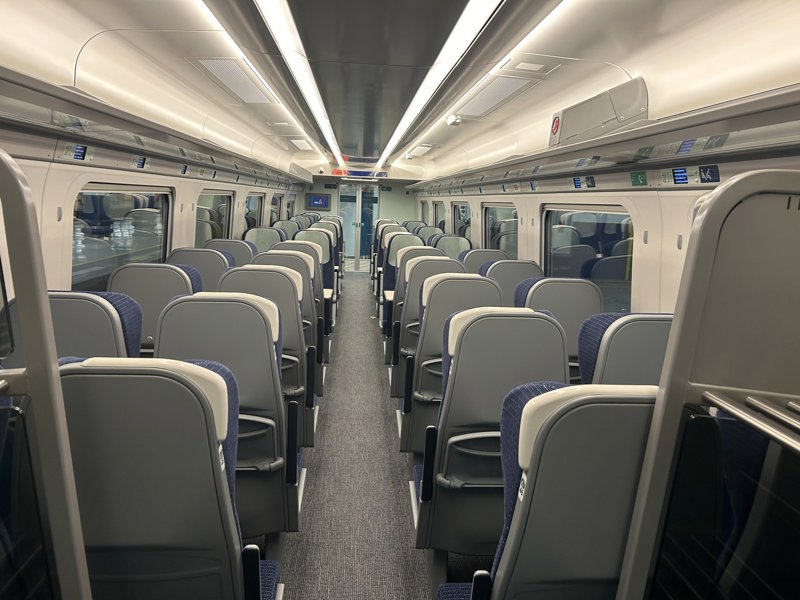
In an incredibly low-key ‘launch’, Avanti West Coast put the first of its ten new Class 807 electric multiple units (EMUs) into traffic on October 26, when 807003 set off on the 0721 Birmingham New Street-Euston.

In an incredibly low-key ‘launch’, Avanti West Coast put the first of its ten new Class 807 electric multiple units (EMUs) into traffic on October 26, when 807003 set off on the 0721 Birmingham New Street-Euston.
The new Hitachi AT 300s are the same train as the Class 800, ‘801’, ‘802’, and ‘803’ designs that have been in use with Great Western Railway, LNER, TransPennine Express, Hull Trains and Lumo since 2017.
The 13 five-car Class 805s and ten seven-car ‘807s’ represent a £350 million investment by the Treniltalia/FirstGroup business that is operating on the West Coast Main Line.
The Class 805s are bi-mode units, which allows Avanti to serve Holyhead with a train that can run under the wires to Crewe and on diesel power west of the Cheshire town.
The ‘807s’, however, are straight electric units (they do not have a ‘get out of jail free’ donkey engine), and will be used alongside Class 390s on those Avanti trains that run wholly on the 25kV AC network.
These 23 new trains will allow Avanti to get rid of the last of 18 five-car Class 221 diesel-electrics. Already the first ten have returned to Beacon Rail (221107/110-118), and some have moved to CrossCountry. But when the last AWC ‘221s’ are relinquished (due to be December 3), six (as yet) do not have a confirmed new home.

While using Class 221s on the Holyhead turns is understandable, a shortage of ‘390s’ to cover all the turns had led to the diagramming of ‘221s’ from Glasgow to Euston (401 miles with ten diesel engines running on an electrified route is not good).
The ‘805s’ and ‘807s’ address this situation, and theoretically Avanti will no longer have to use diesel power other than on those routes that need it. The first ‘805s’ entered traffic earlier this year and now all but two are carrying passengers.
The ‘807s’ could run as 14-car trains, but that would only be in emergencies - for example, one unit rescuing a stricken classmate. But they won’t be able to be rescued by a Class 57 - as there is not enough clearance between the Dellner A-frame and the draw hook.
They will initially be used on the Euston-Wolverhampton and Euston-Liverpool/Blackpool routes (there is no intention to use them to Scotland). They will work alongside the ‘805s’ on the Euston-Birmingham-Wolverhampton route and, of course, the ‘390s’.
An ‘807’ has 451 seats comprising 402 Standard Class and 49 First Class, although those FC seats in Coach H are marketed as Standard Premium (basically a First Class seat, so 2+1 seating, extra legroom and seat width, plus a fixed table, but without an at-seat dining service that a First Class ticket gives you).
It means that Avanti can run some trains with 49 First Class seats and others with 19 First Class and 30 Standard Premium. This compares with 469 seats in a nine-car ‘390’ (370 Standard and 99 First) and 607 seats in an 11-car Pendolino (508 Standard and 99 First).
The ‘807’ has coaches A, B, C, D, E, H and J. And while you might think that suggests there could be scope for inserting extra coaches, in fact it’s to keep the coach lettering the same as a Pendolino (so H and J are First Class). There is a micro-buffet in Coach D, which serves a basic offering of snacks and drinks.

Both the ‘805’ and ‘807’ fleets have been put into traffic without any fanfare. In fact, it was one line in the very helpful fleet updates that AWC regularly provides to the press that indicated that October 26 was the planned first use of an ‘807’ in passenger traffic. And even then, it’s a one-off - the official launch doesn’t come until November.
Of the ten sets, three are passed to carry passengers (807001/003/004). AWC expects to accept one more this month, another four in December, and the final two in January. It hopes that the fleet will enter regular use on November 11 with two diagrams, one replacing a nine-car Pendolino. This will include an additional Liverpool Lime Street-Euston round trip and an additional train from Euston to Blackpool.
By early 2025, all ten will be in use. The ‘807s’ and ‘805s’ (the latter of which has two final sets due in November), will see a further rollout from the start of the December timetable, when AWC plans a number of additional turns across all routes (south of Preston) to be worked by the Hitachi trains.
Leased through Rock Rail, both fleets are based at Oxley and maintained by Hitachi at the West Coast Traincare depot in the Black Country.
Having arrived on the 0721 from Birmingham, the staff at Euston cleaned the train to get it turned round for the 0916 back to Birmingham. While they cleaned, I took some pictures.
This isn’t a train test (that will happen later next year), so it’s merely a ‘first impressions’.

The train is a typical AT300, which means it has those hard seats.
I’m told these are the same seats as those used on the Pendolino refurbishment. While I didn’t get the bad back feeling I get on LNER’s AT300s, they were still a bit hard - but I will cut AWC some slack and assume it is merely because they are brand new and need a bit of breaking in.
The ride of AT300s has also come in for criticism, and again, the ‘807s’ judders about far more than a ‘390’. And if you are sat over the bogies, it’s even worse.
The tables have in-built chargers (as featured on the refurbished Class 390s, RAIL 1009), although it seemed to be painfully slow at actually charging.
There are three-pin plug and USB-A sockets in between the seats in First Class, and in a far better place - on the side of the tables next to the windows - in Standard Class.
I did notice charging the phone off the USB socket was also slow, as was charging a laptop from the three-pin socket. Can the demand for power from a train full of passengers be met by the Class 807’s power supply?
The layout of the train is good, with a refreshingly high number of bays of four seats in Standard Class - it is pleasing to see that AWC hasn’t gone for the ‘pack ’em in’ philosophy of a coach entirely made up of airline seats.
There is, predictably, the inevitable poor seat to window alignment, which is a curse we have to live with in this day and age.
There was a nasty echo on the in-train announcements which was mildly irritating. I also did notice the water dispensers on the three toilets I tried didn’t work - I’ll put that down to an issue in the depot before the unit was despatched, rather than a train fault?
The acceleration on AT300s is superb, and I dare say AWC might be able to shave a few minutes off some schedules with the ‘807s’ on longer journeys with limited or few stops?
Login to continue reading
Or register with RAIL to keep up-to-date with the latest news, insight and opinion.

















Login to comment
Comments
No comments have been made yet.